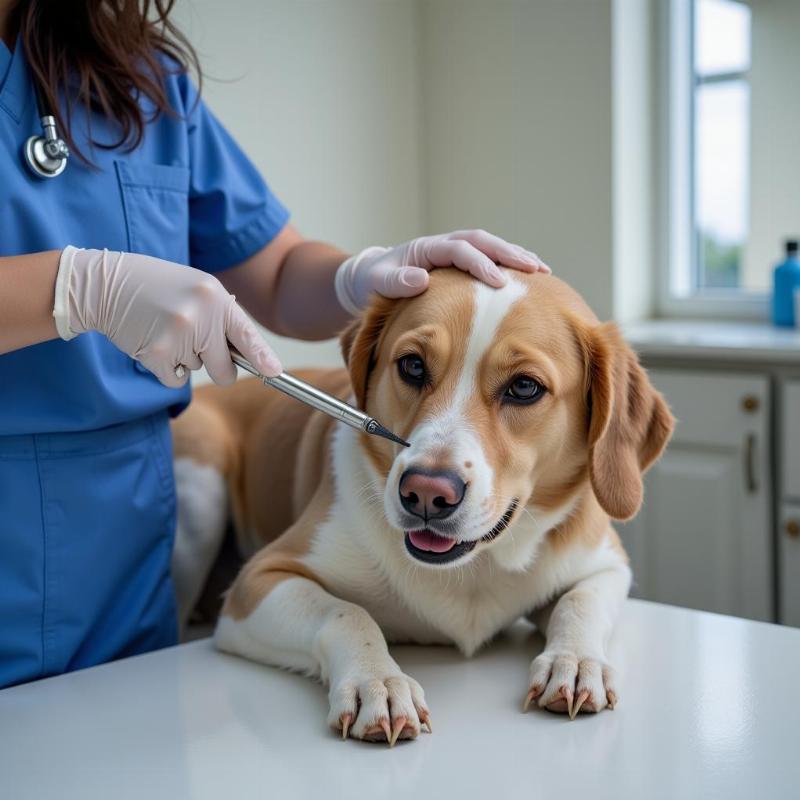Chlorhexidine and ketoconazole spray is a common topical treatment used for various skin conditions in dogs. Understanding its uses, benefits, and potential side effects is crucial for responsible pet owners in the US. This comprehensive guide will provide you with the information you need to ensure your dog’s comfort and well-being.
Understanding Chlorhexidine and Ketoconazole
Chlorhexidine is an antiseptic that effectively kills bacteria and some viruses and fungi. Ketoconazole is an antifungal medication that combats yeast and fungal infections. Combining these two powerful ingredients in a spray creates a broad-spectrum solution for a variety of skin issues.
Common Uses of Chlorhexidine and Ketoconazole Spray
This spray is commonly prescribed for conditions like:
- Hot spots (acute moist dermatitis): These painful, inflamed lesions are often caused by bacterial and fungal overgrowth.
- Ringworm: A highly contagious fungal infection characterized by circular, scaly patches.
- Yeast infections (Malassezia dermatitis): Often causing itchy, greasy skin and a musty odor.
- Pyoderma: Bacterial skin infections that can manifest as pustules, redness, and hair loss.
Applying Chlorhexidine and Ketoconazole Spray
Always follow your veterinarian’s instructions regarding dosage and frequency. Generally, you’ll need to clean the affected area and then apply the spray, ensuring even coverage. Avoid getting the spray in your dog’s eyes, ears, or mouth.
Potential Side Effects
While generally safe, chlorhexidine and ketoconazole spray can sometimes cause mild side effects like temporary skin irritation or discoloration. If you notice any adverse reactions, discontinue use and contact your veterinarian immediately. Rarely, allergic reactions can occur.
When to Consult a Veterinarian
If your dog’s skin condition doesn’t improve within a few days of using the spray, or if it worsens, it’s essential to consult your veterinarian. They can determine the underlying cause and recommend the most appropriate treatment plan.
 Veterinarian Examining Dog's Skin
Veterinarian Examining Dog's Skin
Preventing Skin Infections
Maintaining good hygiene and a healthy diet can help prevent skin infections in your dog. Regular grooming, including bathing with a suitable dog shampoo, can remove excess dirt and debris. A balanced diet supports a healthy immune system and coat.
Conclusion
Chlorhexidine and ketoconazole spray can be an effective treatment for various dog skin conditions. By understanding its uses, application, and potential side effects, you can help your furry friend stay comfortable and healthy. Always consult with your veterinarian for diagnosis and treatment recommendations. Remember, their expertise is crucial in ensuring your dog’s well-being.
FAQs
- How often should I apply the spray? Always follow your veterinarian’s instructions.
- Can I use this spray on puppies? Consult your veterinarian before using this spray on puppies.
- What should I do if my dog licks the sprayed area? While small amounts are generally not harmful, contact your veterinarian if you are concerned.
- Can I use human chlorhexidine/ketoconazole products on my dog? No, always use products specifically formulated for veterinary use.
- How do I store the spray? Store in a cool, dry place, away from direct sunlight and out of reach of children and pets.
- What if my dog has a pre-existing medical condition? Inform your veterinarian of any other health issues your dog may have.
- Are there any alternative treatments available? Your veterinarian can discuss alternative treatment options if necessary.
Beautdogs.us is your leading resource for all things dog-related in the US. We offer expert advice on dog breeds, care, and products, catering to both new and experienced dog owners. Our mission is to empower you with the knowledge and resources to provide the best possible care for your canine companion. Contact us today for personalized support! Email: [email protected], Phone: +1 501-555-7529. Visit Beautdogs.us for more information.